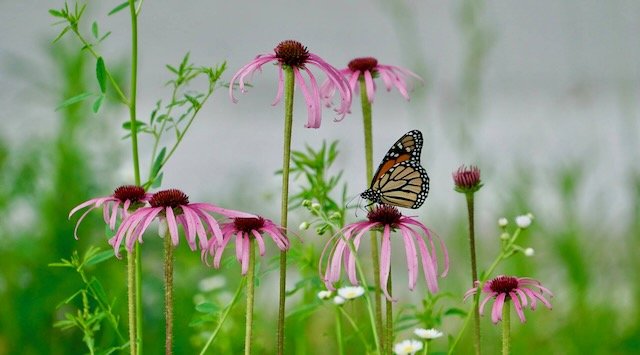The secret to having Monarch Butterflies in your yard is milkweed. That’s it!!! The relationship between Monarch butterflies, their caterpillars and milkweed is not a casual one. It has developed over thousands of years. As a result…the caterpillars are very selective…picky eaters. Chemicals produced within all milkweeds protect the plants from being eaten by most animals…but not Monarchs. Monarchs are able to consume and deposit these same chemicals within their own bodies. This makes them taste very bad and protects them from many predators
Milkweed is the only thing a Monarch caterpillar can eat in order to grow and transform into the Monarch butterfly we all know and love. Without caterpillars…there would be no butterflies. Milkweed is considered their host plant. Female Monarchs come to milkweed plants to lay their eggs, because they don't have a choice. Milkweed is the only plant a female Monarch will use to lay her eggs. If you want to guarantee that Monarch butterflies come to your yard or garden, you have got to plant some variety of milkweed.
If you’ve been thinking about planting this season, November is definitely the best time for most of us to complete this simple task. In SW Missouri, we should have experienced our first frost by then, but it’s too warm for the ground to be frozen and too cold for seeds to sprout prematurely.
Fall is the best time for planting, since seeds need a cold treatment, called cold stratification, before they will sprout. Old Man Winter can take care of this naturally…or seeds can be kept in cold storage in a garage or outside building, or even collected from pods that wintered outdoors. Otherwise, they must be kept in the refrigerator for about 6 weeks prior to planting.
Tips on different ways for planting milkweed seeds:
1. The easiest way is to sprinkle some seeds around where you want them to grow after a killing frost. In southwest Missouri this would be late October. Make sure seeds have good contact with the soil. The seeds experience winter and know when it’s time to get growing in the spring. Definitely the easiest method, but it’s hard to remember to look for them in the spring and to recognize the seedlings, so a plant label or other marker is advisable.
2. A better method would be:
A. Scrape off any weeds, rocks or other debris several weeks ahead of time in the area where you want to plant milkweed. To ensure success when establishing any native plant from seed, it is critical to first eliminate existing weed cover and reduce the amount of weed seed in the soil. Repeated shallow cultivation prior to planting is usually effective (The secret is to NOT scratch the surface deeply which can pull too many weed seeds up to the surface where they can grow and compete with your seedlings.)
B. Just before planting (after the first killing frost) scratch the surface again to loosen the soil. Use the length of your hand to estimate approximate seed spacing. Cover the seeds lightly and water them into place. NOTE: Seeds can move over winter and some won’t germinate so exact spacing now is a waste of time.
C. A label and a LIGHT coating of FINE mulch are good ideas, but no further care is needed until springtime when you should water seedlings during their first season as needed.
D. 1-2 months after your seedlings have sprouted next spring, consider transplanting to achieve correct spacing for your specific milkweed.
3. Rather than just sprinkling the seeds at random, you might want to sow them in pots in the fall after a killing frost, insert a plant label, and then sink the pots into the ground to wait for spring. A plant label is important!
4. If you choose to wait until springtime to plant your seeds, you will need to give them a cold treatment called stratification. To do this:
A. Combine seeds with an equal or greater volume (up to 3 times) of dampened sand, perlite, vermiculite, or other sterile media. The media should be damp, not wet; it should not drip when squeezed! Some people place seeds between damp paper towels.
B. Place seed and media in a sealed plastic bag and store the bag in your refrigerator (NOT freezer) for about 6 weeks until you are ready to plant. This is “artificial winter” for the seeds.
C. Whether seeds are sown indoors or outdoors, the soil in the planted area must be kept moist for the entire germination period.
Patience is necessary! Even under ideal conditions, milkweed planted from seed may require more than one growing season to appear and become established. Try to have groups of at least 3 to 6 plants in order to more effectively catch the attention of passing Monarchs. Carefully weed your milkweed garden to encourage growth of the milkweed.
Also, while Monarch caterpillars munch only milkweed, the adult Monarch butterflies sip their food from nectar supplying flowers, including milkweed. To lure them in, it is also important to have other flowers with nectar to furnish an attractive buffet. When you are planting nectar sources, try to choose plants that will provide flowers throughout the growing season. Asters and Goldenrod are especially helpful during Monarch fall migration.
If you are impatient, you can always purchase native milkweed from a source in your area. In Missouri,we always recommend Missouri Wildflower Nursery (http://www.mowildflowers.net/).
Remember, it is important to plant both nectar flowers and milkweed native to your area when you want to invite a Monarch to lunch!



